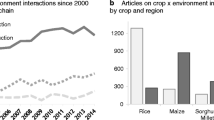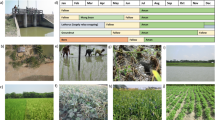Abstract
To determine the most important production constraints and associated yield losses for six major food crops in 13 farming systems with high poverty in Sub-Saharan Africa, South Asia and East Asia, surveys were conducted with 672 experts representing a diversity of backgrounds and experience. Respondents reported large gaps between highest achieved crop yield on smallholder farms and average yield on farm. Yield gaps were smallest for rice (about 60% of current average smallholder farm grain yields), mid size for wheat and cassava, and larger (sometimes double current farm yields) for sorghum, cowpea and chickpea. Gaps were also smaller in the high input and yield farming systems of East Asia and largest in the marginal, drier systems, particularly in Sub-Saharan Africa. Four categories of production constraint (abiotic, biotic, management and socio-economic) were considered important contributors to yield gaps. A diversity of specific constraints was reported for the crops in the different systems. The most severe and widespread specific constraints for wheat involved the deficiency, high cost and poor management of N fertilizer, and problems associated with drought stress at grain filling, mid season drought and irrigation management. Those for rice included N fertilizer problems, soil fertility depletion, various leaf, stem and head pests and diseases, weed competition and inadequate water management. Striga and weed competition, soil resource degradation, poor soil fertility management, and drought were the most severe specific constraints for sorghum. Insect pests of pod, leaf, stem and flower and the high cost of their control dominated the constraint set for cowpea. Helicoverpa pod borer, Botrytis grey mould and control costs were the most severe for chickpea. Unsuitable varieties/poor seed, soil infertility and fertilizer constraints were also widespread with the legumes. Marketing problems and lack of finance were concerns for cassava along with weed competition, African cassava mosaic virus and poor varieties/planting materials. The findings can help to inform priority setting for international agricultural research and development activities on important food crops in major farming systems occupying areas of high poverty.

Similar content being viewed by others
Notes
The complete report of this study, including detailed annexes on additional constraints, constraint interactions, systems effects and effects on income and health is available at: http://www.generationcp.org/sp5_impact/targeting-and-focus#dixon along with information on proposed solutions to priority constraints.
References
Adipala E, Nampala P, Karungi J, Isubikalu P (2000) A review on options for management of cowpea pests: experiences from Uganda. Integr Pest Manag Rev 5(3):185–196
Alston JM, Norton GW, Pardey PG (1995) Science under scarcity: principles and practice for agricultural research evaluation and priority setting. Cornell University Press, Ithaca, p 513
Asiwe JAN (2007) Baseline survey on the production practices, constraints and utilization of cowpea in South Africa: implications for cowpea improvement. ISHS Acta Horticulturae 752:381–385
Berger JD (2007) Ecogeographic and evolutionary approaches to improving adaptation of autumn-sown chickpea (Cicer arietinum L.) to terminal drought: the search for reproductive chilling tolerance. Field Crops Res 104:112–122
Byerlee D (2000) Targeting poverty alleviation in priority setting for agricultural research. Food Policy 25(4):429–445
Carter S, Murwira HK (1995) Spatial variability in soil fertility management and crop response in Mutoko Communal Area, Zimbabwe. Ambio 24:77–84
Cassman KG (1999) Ecological intensification of cereal production systems: yield potential, soil quality, and precision agriculture. Proc Natl Acad Sci USA 96:5952–5959
Chatrath R, Mishra B, Ortiz-Ferrara G, Singh SK, Joshi AK (2007) Challenges to wheat production in South Asia. Euphytica 157:447–456
Chiduza C, Waddington SR, Rukuni M (1995) Evaluation of sorghum technologies for smallholders in a semi-arid region of Zimbabwe (Part I): production practices and development of an experimental agenda. J Appl Sci South Afr 1:1–9
Chikoye D, Ekeleme F, Ambe JT (1999) Survey of distribution and farmers’ perceptions of speargrass [Imperata cylindrica (L.) Raeuschel] in cassava-based systems in West Africa. Int J Pest Manag 45(4):305–311
Collinson M (ed) (2000) A history of farming systems research. CABI, Wallingford, p 448
Cui Z, Chen X, Zhang F, Xu J, Shi L, Li J (2008) Analysis on fertilizer applied and the central factors influencing grain yield of wheat in the Northern China plain. Acta Agriculturae Boreali-Sinica 23(6):224–229
Dalkey NC (1969) The Delphi method: an experimental study of group opinion. The Rand Corporation, Santa Monica, p 79
De Datta SK, Gomez KA, Herdt RW, Barker R (1978) A handbook on the methodology for an integrated experiment—survey on rice yield constraints. International Rice Research Institute, Los Baños
Dey MM, Miah MNI, Mustsfi BAA, Hossain M (1996) Rice production constraints in Bangladesh: implications for further research priorities. In: Evenson RE, Herdt RW, Hossain M (eds) Rice research in Asia: progress and priorities. CAB International in association with the International Rice Research Institute, Wallingford, pp 179–191
Dixon J, Gulliver A, Gibbon D (2001) Farming systems and poverty: improving farmers’ livelihoods in a changing world. FAO and World Bank, Rome, p 412
Dixon J, la Rovere R (2009) Highlights of the evolution of priority setting and targeting at the international center for maize and wheat improvement (CIMMYT). In: Raitzer DA, Norton GW (eds) Prioritizing agricultural research for development. CABI, Wallingford, pp 136–155
Duveiller E, Singh RP, Nicol JM (2007) The challenges of maintaining wheat productivity: pests, diseases and potential epidemics. Euphytica 157:417–430
East Africa Root Crops Research Network (EARRNET) (2006) The cassava sub-sector analysis. http://www.asareca.org/earrnet/cassava_sub-sector_analysis.htm
Evans LT, Fischer RA (1999) Yield potential: it’s definition, measurement, and significance. Crop Sci 39:1544–1551
Evenson RE, Herdt RW, Hossain M (eds) (1996a) Rice research in asia: progress and priorities. CAB International in association with the International Rice Research Institute, Wallingford
Evenson RE, Herdt RW, Hossain M (1996b) Priorities for rice research: introduction. In: Evenson RE, Herdt RW, Hossain M (eds) Rice research in asia: progress and priorities. CAB International in association with the International Rice Research Institute, Wallingford, pp 3–15
Giller K, Rowe EC, de Ridder N, van Kuelen H (2006) Resource use dynamics and interactions in the tropics: scaling up in space and time. Agric Syst 88:8–27
Gibbon D, Dixon J, Flores D (2007) Beyond drought tolerant maize: study of additional priorities in maize. Report to Generation Challenge Program. CIMMYT Impacts, Targeting and Assessment Unit, CIMMYT. México DF, México, p 42
Hobbs PR, Sayre KD, Ortiz-Monasterio JI (1998) Increasing wheat yields sustainably through agronomic means. NRG Paper 98-01. CIMMYT, México D.F., México, p 22
Hyman G, Fujisaka S, Jones P, Wood S, de Vicente C, Dixon J (2008) Strategic approaches to targeting technology generation: assessing the coincidence of poverty and drought-prone crop production. Agric Syst 98:50–61
IITA (2007) Constraints to cassava production. http://www.iita.org/cms/details/cassava_project_details.aspx?zoneid=63&articleid=267
Johansen C, Baldev B, Brouwer JB, Erskine W, Jermyn WA, Li-Juan L, Malik BA, Ahad Miah A, Silim SN (1994) Biotic and abiotic stresses constraining productivity of cool season food legumes in Asia, Africa and Oceania. In: Muehlbauer FJ, Kaiser WJ (eds) Expanding the production and use of cool season food legumes. Kluwer, Dordrecht, pp 175–194
Joshi AK, Mishra B, Chatrath R, Ortiz-Ferrara G, Singh RP (2007) Wheat improvement in India: present status, emerging challenges and future prospects. Euphytica 157:431–446
Kosina P, Reynolds MP, Dixon J, Joshi A (2007) Stakeholder perception of wheat production constraints, capacity building needs, and research partnerships in developing countries. Euphytica 157:475–483
Kossou DK, Gbèhounou G, Ahanchédé A, Ahohuendo B, Bouraïma Y, van Huis A (2001) Indigenous cowpea production and protection practices in Benin. Insect Sci Applic 21(2):123–132
Kudadjie CY, Struik PC, Richards P, Offei SK (2004) Assessing production constraints, management and use of sorghum diversity in north-east Ghana: a diagnostic study. NJAS Wageningen J Life Sci 52(3–4):371–391
Kumar A, Singh R, Shoran J (2007) Constraints analysis of wheat cultivation in eastern India. Indian J Agric Res 41(2):97–101
Lin JY, Shen M (1996) Rice production constraints in China. In: Evenson RE, Herdt RW, Hossain M (eds) Rice research in Asia: progress and priorities. CAB International in association with the International Rice Research Institute, Wallingford, pp 161–178
Mills B (ed) (1998) Agricultural research priority setting: information investments for improved use of resources. ISNAR (International Service for National Agricultural Research). The Hague, The Netherlands, p 151
Pande S, Stevenson P, Narayana Rao J, Neupane RK, Chaudhary RN, Grzywacz D, Bourai VA, Krishna Kishore G (2005) Reviving chickpea production in Nepal through integrated crop management, with emphasis on Botrytis gray mold. Plant Dis 89:1252–1262
Pandey S, Bhandari H, Hardy B (eds) (2007) Economic costs of drought and rice farmers’ coping mechanisms: a cross-country comparative analysis. International Rice Research Institute, Los Baños
Peng S, Cassman KG, Virmani SS, Sheehy J, Khush GS (1999) Yield potential trends of tropical rice since the release of IR8 and the challenge of increasing rice yield potential. Crop Sci 39:1552–1559
Ratanawaraha C, Senanarong N, Suriyapan P (2001) Status of cassava in Thailand: implications for future research and development. In: a review of cassava in Asia with country case studies on Thailand and Viet Nam. Proceedings of the validation forum on the global cassava development strategy, 26–28 April 2000. FAO, Rome, Italy, p 92
Reddy BVS, Ramesh S, Borikar ST, Hussain Sahib K (2007) ICRISAT–Indian NARS partnership sorghum improvement research: strategies and impacts. Curr Sci 92(7):909–915
Reynolds MP, Pietragalla J, Braun H-J (2008) International symposium on wheat yield potential: challenges to international wheat breeding. CIMMYT, México DF, p 197
Ryoichi M, Singh BB, Moutari A, Satoshi T, Keiichi H, Akira K (2006) Cowpea cultivation in the Sahelian region of West Africa: farmers’ preferences and production constraints. Nettai Nogyo 50(4):208–214
Shumba EM, Bernstein RH, Waddington SR (1990) Maize and groundnut yield gap analysis for research priority setting in the smallholder sector of Zimbabwe. Zimb J Agric Res 28:105–113
Smith P (2001) Priority setting in agricultural research: beyond economic surplus methods. Public Adm Dev 21(5):419–428
Sui X (2007) Factors affecting rice yield in Dandong area and countermeasures. Journal of North Rice (China) 3:111–113
Van Rheenen HA, Singh O (1997) Chickpea in ICRISAT programmes. Grain Legumes 17:24–26
Widawsky DA, O’Toole JC (1996) Prioritizing the rice research agenda for eastern India. In: Evenson RE, Herdt RW, Hossain M (eds) Rice research in Asia: progress and priorities. CAB International in association with the International Rice Research Institute, Wallingford, pp 109–129
Wubeneh NG, Sanders JH (2006) Farm-level adoption of sorghum technologies in Tigray, Ethiopia. Agric Syst 91(1–2):122–134
Wydra K, Verdier V (2002) Occurrence of cassava diseases in relation to environmental, agronomic and plant characteristics. Agric Ecosyst Environ 93(1–3):211–226
Acknowledgements
We thank the 672 panelists that provided the crop and system constraints data for this study. We also thank the regional focal persons and others for their invaluable help with organizing responses from panelists. Focal persons included Arun Joshi, Jagadish Timsina, Enamul Haque, Lal Amgain, and He Zhonghu in Asia; Shephard Siziba, Victor Okoruwa, Patrice Adégbola, Wondwossen Tsegaye, Fasil Kelemework and Franklin Simtowe in Africa. Federico Carrion of CIMMYT ITAU was responsible for much of the data input and management. David Gibbon reviewed the complete report on which this paper is based. The study was commissioned and funded by the CGIAR Generation Challenge Program Sub Program 5 on Capacity Building and Enabling Delivery.
Author information
Authors and Affiliations
Corresponding author
Electronic supplementary material
Below is the link to the electronic supplementary material.
ESM 1
(DOC 274 kb)
Rights and permissions
About this article
Cite this article
Waddington, S.R., Li, X., Dixon, J. et al. Getting the focus right: production constraints for six major food crops in Asian and African farming systems. Food Sec. 2, 27–48 (2010). https://doi.org/10.1007/s12571-010-0053-8
Received:
Accepted:
Published:
Issue Date:
DOI: https://doi.org/10.1007/s12571-010-0053-8




